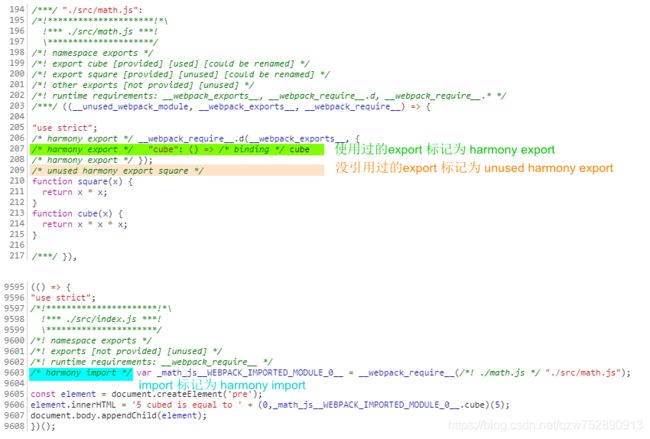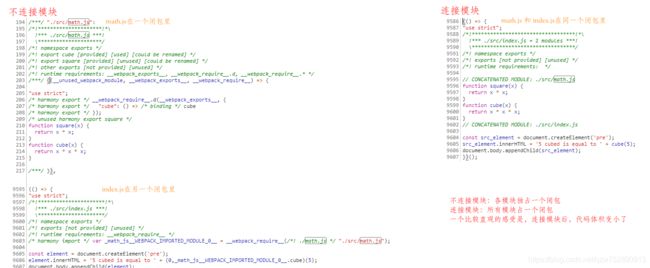webpack之 tree shaking
文章目录
-
-
- tree shaking
- SideEffectsFlagPlugin
- ModuleConcatenationPlugin
- TerserWebpackPlugin
- 参考文章
-
tree shaking
//math.js
export function square(x){
return x*x;
}
export function cube(x){
return x*x*x;
}
//index.js
import {
cube} from './math.js';
const element = document.createElement('pre');
element.innerHTML = '5 cubed is equal to ' + cube(5);
document.body.appendChild(element);
//webpack.config.js
//webpack verson:^5.0.0-beta.17
const path = require('path');
const HtmlWebapckPlugin = require("html-webpack-plugin");
const {
CleanWebpackPlugin} = require("clean-webpack-plugin");
module.exports = {
mode:'development',
devtool:'cheap-source-map',
// mode:'production',
devServer:{
port:3000,
contentBase:path.join(__dirname,'dist')
},
entry:"./src/index.js",
output:{
filename:"bundle.js",
path:path.join(__dirname,"dist")
},
module:{
rules:[
{
test:/\.js$/,
include:/src/,
exclude:/node_modules/,
use:{
loader:'babel-loader',
options:{
// presets:['@babel/preset-react']
// presets:[
// [
// '@babel/preset-env',{
// modules:false
// }
// ]
// ]
}
}
},
{
test:/\.css$/,
include:/src/,
use:['style-loader','css-loader']
}
]
},
plugins:[
new HtmlWebapckPlugin({
template:'./index.html'
}),
new CleanWebpackPlugin()
]
}
webpack会对代码作如下标记:
- 所有
import标记为harmony import - 引用到的
export标记为harmony export,没引用到的export标记为unused harmony export
本例中,math.js导出了square和cube,但index.js中只使用了cube,没有使用square,所以math.js中cube是harmony export,square是unused harmony export。


math.js导出了square和cube,而square并没有被使用。说白了,square多余了,完全没有必要打包到bundle.js里,否则徒增代码体积。
将mode设置为production,webpack在打包过程中会将 没有使用的导出内容 排除出最终包。 以上过程就是 tree shaking。

有两个疑问:
- 首先,为什么只有
ES Module(import/export)下才可以tree shaking?
构建时通过静态分析,分析出代码之间的依赖关系。把我们的代码想象成一棵树,各依赖项就是树上的节点,把无用的依赖项从构建结果中删除,就是tree shaking。
要静态分析,代码就不能变来变去。像有 动态导入,按需加载的代码就没有办法做静态分析。
ES Module的设计思想就是尽量使代码静态化,使得在编译时就可以确定依赖关系,而不是非得到运行时才确定。 - 然后,为什么
mode:'production'就实现了tree shaking?webpack做了啥?DefinePlugin中process.env.NODE_ENV的值设置为production
相当于new webpack.DefinePlugin({ "process.env.NODE_ENV": JSON.stringify("production") })- 启用了
SideEffectsFlagPlugin - 启用了
ModuleConcatenationPlugin - 启用了
TerserWebpackPlugin
其中,SideEffectsFlagPlugin+ModuleConcatenationPlugin 将
没有使用的且没有副作用的模块排除出包(移除未使用的模块)、TerserPlugin将没有使用的代码语句排除出包(移除未使用的代码)
SideEffectsFlagPlugin
先举个例子来了解下 SideEffects,副作用。
新增一个模块文件util.js。
export function getDate(){
return new Date().toLocaleDateString();
}
在index.js里导入util.js的getDate方法,但不调用。
//index.js
import {
cube} from './math.js';
import {
getDate} from './util.js'
const element = document.createElement('pre');
element.innerHTML = '5 cubed is equal to ' + cube(5);
document.body.appendChild(element);
mode:'production',构建的结果里没有util.js的任何痕迹。也就是说,没有被使用的且没有副作用的模块util.js被移除了。

现在,在util.js中添加一句console.log('hello world'),即
//util.js
export function getDate(){
return new Date().toLocaleDateString();
}
console.log('hello world');
编译后的结果里,从util.js导入的getDate方法因为没有被调用,删除肯定不影响功能,所以直接移除就好。但util.js里的console.log('hello world'),编译器就无法判断这句到底是干嘛的,保险起见,当然最好不移除。也就是说,console.log('hello world')被编译器认定为有副作用了,有副作用的东西不能删除。

还有像 修改全局变量如window.name='testing'等等 都是 副作用。
与 副作用 相反的就是 纯函数。像react的UI=render(data),就是一个纯函数。 输出UI完全依赖输入data,只要输入相同,输出就一定相同。
再回到 副作用的 这个例子。
console.log('hello world'),编译器不知道它是干嘛的,但我们知道啊。我们可以告诉webpack这句明显是没啥用,完全可以删除它。
怎么告诉?在package.json里添加"sideEffects":false。
"sideEffects":false告诉webpack,所有的代码都是没有副作用的,没有使用到的你放心删掉就好了。

"sideEffects":false是不是很妙?不见得。
我们再在index.js导入index.css。
//index.css
body{
font-weight:bold;
color:indianred;
}
//index.js
import {
cube} from './math.js';
import {
getDate} from './util.js';
import './index.css';
const element = document.createElement('pre');
element.innerHTML = '5 cubed is equal to ' + cube(5);
document.body.appendChild(element);
情况不妙,样式并没有加上。因为index.css是没有被使用的代码,且"sideEffects":false后它已经被webpack认定是无副作用的,所以index.css被移除了。
怎么破?有两种方式。
- 第一种,依然得靠
package.json里的sideEffects属性
"sideEffects":["*.css"]告诉webpack,所有的.css文件都是有副作用的,构建时不要移除
//package.json
"sideEffects":["*.css"]
- 第二种,可以在
module.rule里设置sideEffects,但请注意,是布尔值
//webpack.config.js
{
test:/\.css$/,
include:/src/,
use:['style-loader','css-loader'],
sideEffects:true
}
好了,我们已经了解副作用 以及 模块有无副作用该如何标注。
SideEffectsFlagPlugin则会分析模块之间的依赖关系,没有使用且没有副作用的模块将被打上 无副作用的 标记。
ModuleConcatenationPlugin
它的作用是作用域提升,更直白一点讲,是将多个模块合并到一个模块里。
开启该功能有两种方式。
//第一种
plugins:[
new webpack.optimize.ModuleConcatenationPlugin()
]
//第二种
optimization:{
concatenateModules :true
}
mode:'development'和devtool:'cheap-source-map'下, ModuleConcatenationPlugin开启前后的对比。

不启用ModuleConcatenationPlugin:各个模块独占一个闭包;
启用ModuleConcatenationPlugin:所有模块占一个闭包。
最直观的一个感受是,启用ModuleConcatenationPlugin后,代码体积变小了些。模块越多,感受越明显。
SideEffectsFlagPlugin会给 没有被使用且没有副作用的模块打上 无副作用的 标记,而这些被打上标记的模块会被ModuleConcatenationPlugin跳过,不被合并入最终模块,即被排除出最终包。
TerserWebpackPlugin
TerserWebpackPlugin会使用terser压缩js。
以前会用插件UglifyjsWebpackPlugin,它会使用uglifyjs压缩js,但因为uglifyjs仅支持ES5,而terser支持ES6+,所以现在用TerserWebpackPlugin替代UglifyjsWebpackPlugin。
前面sideEffects+SideEffectsFlagPlugin+ModuleConcatenationPlugin从模块层面上移除了 没有使用且没有副作用的代码。
TerserPlugin从代码语句层面上移除了 没有副作用的代码。
/*#__PURE__*/将函数调用标识为无副作用
还是看例子。
export function getDate(){
return new Date().toLocaleDateString();
}
function sayHi(){
console.log('hello world');
}
sayHi();
mode:'production'编译后的结果里有console.log('hello world')。

现在,我们在sayHi函数调用前添加这么一行注释/*#__PURE__*/,`即
export function getDate(){
return new Date().toLocaleDateString();
}
function sayHi(){
console.log('hello world');
}
/*#__PURE__*/sayHi();
/*#__PURE__*/将函数调用标识为无副作用。
瞧,无副作用的sayHi()被移除了。

pure_funcs将函数标记为无副作用
除了/*#__PURE__*/这个方法外,还可以用pure_funcs将sayHi标记函数为无副作用。
const TerserPlugin = require('terser-webpack-plugin');
module.exports = {
devtool:'cheap-source-map',
mode:'production',
optimization: {
concatenateModules:true,
minimize: true,
minimizer:[
new TerserPlugin({
terserOptions:{
compress:{
pure_funcs:['sayHi'],
drop_console:true
}
}
})
]
}
}
terserOptions.compress对象里可以设置很多属性,可以到这里看看。
在开发阶段我们可能会使用很多console.log打印日志,但发布的时候肯定要删除这些,将terserOptions.compress.drop_console设置为true就好。
参考文章
Tree Shaking in Webpack
代码体积减少80%!Taro H5转换与优化升级
UglifyjsWebpackPlugin
TerserWebpackPlugin
UglifyJS
terser